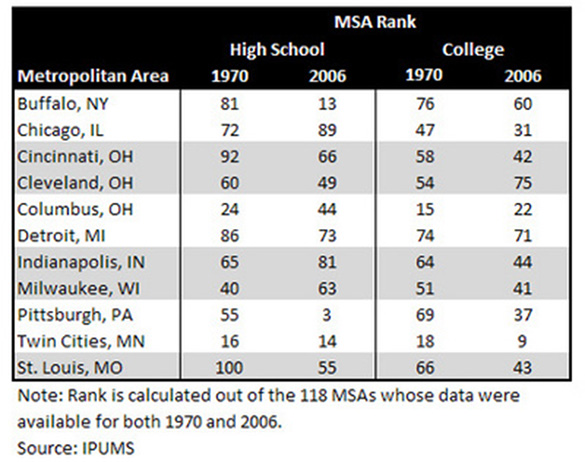The lust for density is pornographic. As Tony Hsieh might say about his Downtown Las Vegas project, density is a key driver of economic vitality. I’ve already quoted the Detroit Regional Chamber as claiming talent retention is a key driver of economic vitality. Next up, greater diversity is a key driver of economic vitality:
The change in Minneapolis wasn’t an accident. The community made a major effort to resettle southeast Asian refugees into the Twin Cities and to help migrant farmworkers become homeowners in rural areas. As a result, Minneapolis had the 11th-highest growth in Hispanic residents and the 12th-highest growth in Asian residents among the top 40 regions between 1980 and 2010.
By comparison, during the same time period, Pittsburgh ranked 37th and 35th in attracting Hispanic and Asian residents. Minneapolis still has a smaller percentage of African-American residents than Pittsburgh does, but it’s had the second-highest growth in African-Americans over the past 30 years among major regions, whereas Pittsburgh has had the fifth-slowest growth, so Minneapolis will likely soon surpass us on that measure, too.
Expanding diversity certainly hasn’t hurt the Minneapolis economy. Jobs in the Minneapolis region grew four times as fast as they did in Pittsburgh over the past decade. Moreover, the unemployment rate in Minneapolis in March was only 5.3 percent, significantly lower than the 7.1 percent unemployment rate in Pittsburgh, so it seems that attracting new residents has benefited everyone in the Minneapolis region.
Much of this opinion piece is devoted to boosting Pittsburgh’s population, wasting precious column space. The author (Harold D. Miller) makes a big deal about demographic decline at the expense of other considerations, such as economic growth. The connection drawn between diversity and job creation has more weight. Less unemployment is a better goal than a boom in dependents residing in the region.
One test of the diversity hypothesis:
The diversity of people has economic costs and benefits. Using recent immigration data from 195 countries, we propose an index of diversity based on people’s birthplaces. This new index is decomposed in a “size” (share of foreign born) and a variety (diversity of immigrants) component and is available for 1990 and 2000 and for the overall as well as for the high (workers with college education) and low-skill fractions of the workforce. We show that birthplace diversity is largely uncorrelated with ethnic and linguistic fractionalization and that—unlike fractionalization—it is positively related to economic development even after controlling for education, institutions, ethnic and linguistic fractionalization, trade openness, geography, market size, and origin-effects. This positive association appears particularly strong for the diversity of skilled immigrants in richer countries.
Before I get started with the discussion, a caveat from the same research:
Albeit loosely linked through immigration, ethnic and birthplace diversity are empirically (perhaps surprisingly) almost completely uncorrelated.
So, a place such as Pittsburgh could have a larger African-American population than Minneapolis (i.e. greater racial diversity) but less birthplace diversity. In fact, ethnic diversity is not positively related to economic development. The boon is receiving a migrant from somewhere else, birthplace diversity.
Another hole in Harold Miller’s persuasive essay concerns segregation. Tremendous ethnic and racial diversity locked up in poor neighborhoods on Chicago’s South Side does little good for the regional economy. What is the key driver for of economic vitality in Chicago? Talent attraction.
Miller cherry-picked Minneapolis for comparison’s sake. Many Rust Belt cities, such as Cleveland and Detroit, have more foreign born than Pittsburgh does. Why aren’t those cities doing better?
Minneapolis does well because it was less dependent on manufacturing and had a higher educational attainment rate (percentage of workers with a college degree). With a starting point of 1970, Minneapolis was in much better economic position than Pittsburgh:
In considering educational attainment of the populations, the table below displays the ranks of Great Lakes metropolitan areas among 118 metropolitan areas in 1970 and 2006. The two local leaders in 1970 college attainment, Columbus, Ohio, and the Twin Cities also experienced the fastest employment growth. While Pittsburgh ranked low in college attainment in 1970, its gains in this metric since then have been the most rapid. Perhaps not accidentally, Pittsburgh’s growth in per capita income also outpaced other cities in the region.

Emphasis added. Pittsburgh’s “rapid” rise in college attainment occurred without the benefit of substantial migration to the area. But most of those brains were local. Pittsburgh excels at talent retention. And as we all know, talent retention is a key driver of economic vitality.
The concerns about Pittsburgh innovation and job growth are warranted. However, too much is put at the feet of diversity. Pittsburgh lacks migrants, outsiders. A diverse population can be plenty xenophobic and unproductive, as well as segregated and isolated. Furthermore, not all college graduates are equal. Talent from other states or countries are better than the homegrown crop. Forget density, talent retention, and diversity. Geographic mobility is a key driver of economic vitality.



